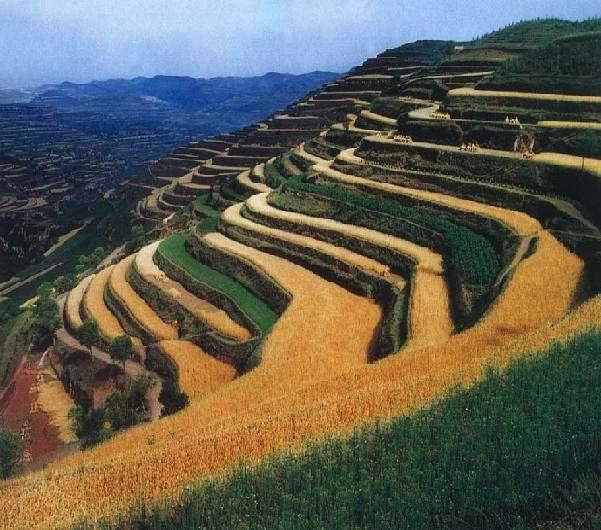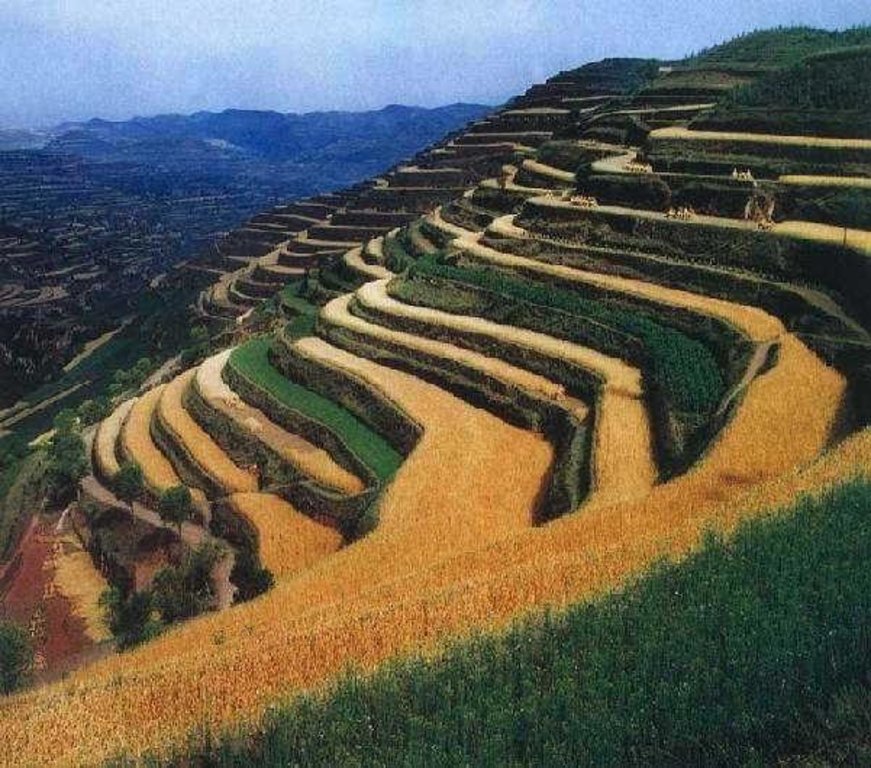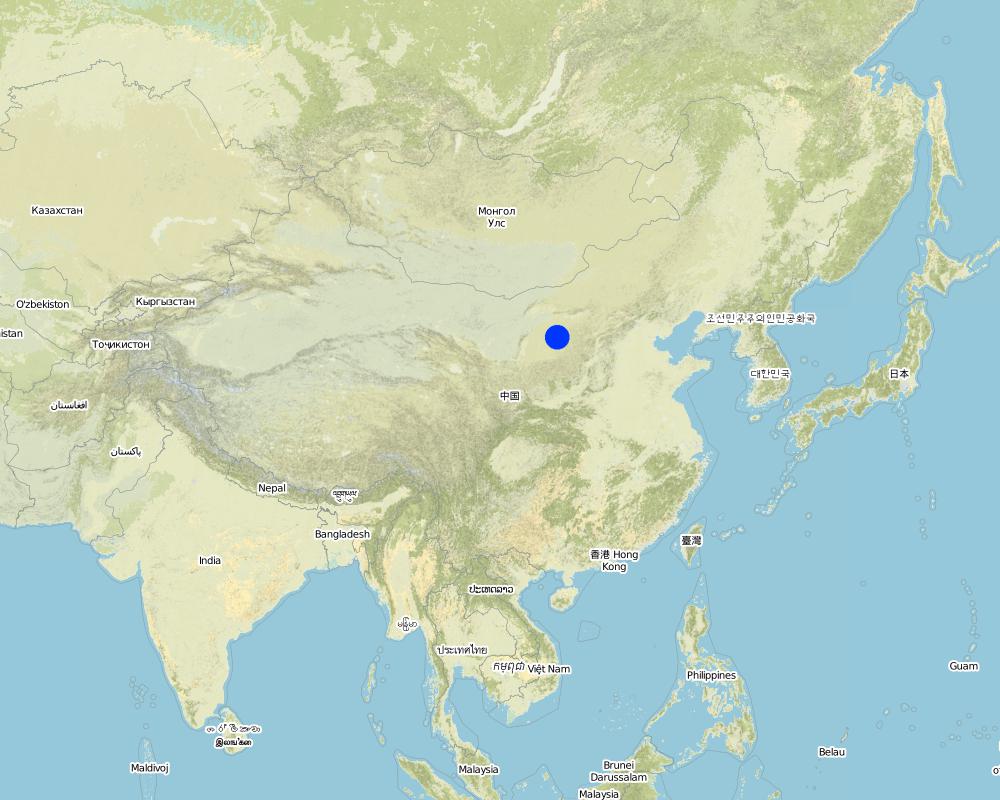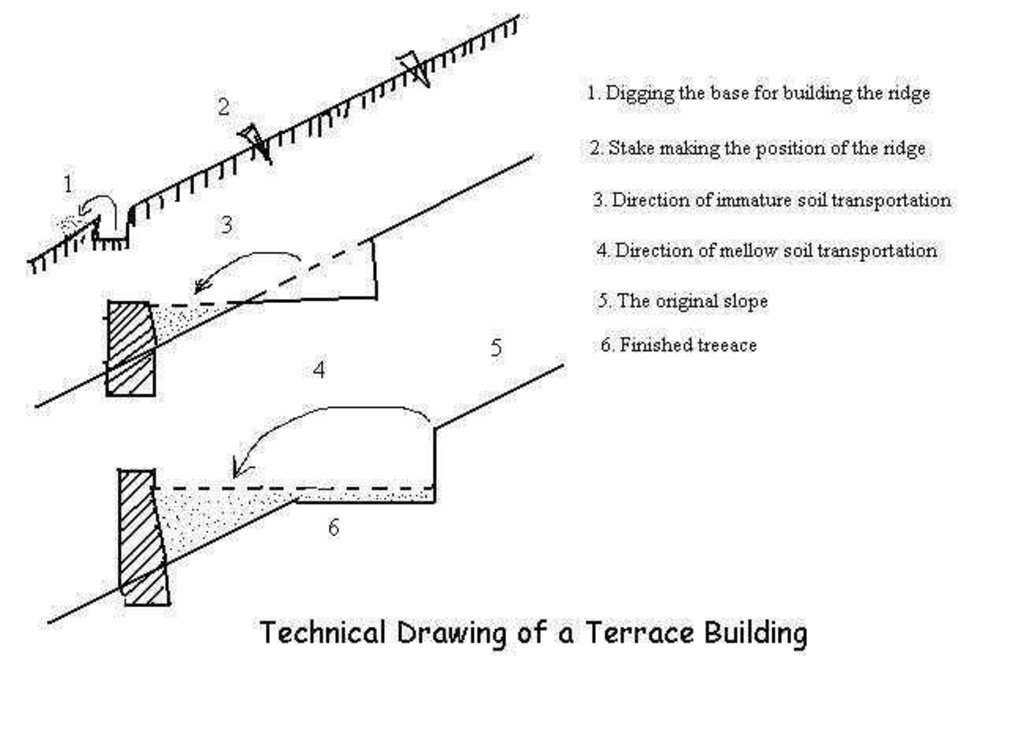Terrace [Chine]
- Création :
- Mise à jour :
- Compilateur : Meili WEN
- Rédacteur : –
- Examinateurs : David Streiff, Alexandra Gavilano
Terrace
technologies_1367 - Chine
Voir les sections
Développer tout Réduire tout1. Informations générales
1.2 Coordonnées des personnes-ressources et des institutions impliquées dans l'évaluation et la documentation de la Technologie
Nom du ou des institutions qui ont facilité la documentation/ l'évaluation de la Technologie (si pertinent)
Department of Resources and Environmental Science, Beijing Normal University (Department of Resources and Environmental Science, Beijing Normal University) - Chine1.3 Conditions relatives à l'utilisation par WOCAT des données documentées
Le compilateur et la(les) personne(s) ressource(s) acceptent les conditions relatives à l'utilisation par WOCAT des données documentées:
Oui
2. Description de la Technologie de GDT
2.1 Courte description de la Technologie
Définition de la Technologie:
A terrace is a kind of measure to change the slope, which has a raised bank of earth or stone with vertical or sloping sides and a approximately flat top.
2.2 Description détaillée de la Technologie
Description:
A terrace has a raised bank of earth or stone with vertical or sloping sides and a approximately flat top. It can reduce slope angle and length, retain runoff, increase infiltration and reduce the soil loss. Crops can grow well because water increases in soils. Meanwhile, ground cover is improved. Terrace can be constructed by manual labor or machine. Firstly, determining the width of the field according to the slope angle and soil texture. Secondly, putting the topsoil aside. Thirdly, leveling up the slope and constructing banks. At last, putting the topsoil to the top of the flat surface.
2.3 Photos de la Technologie
2.5 Pays/ région/ lieux où la Technologie a été appliquée et qui sont couverts par cette évaluation
Pays:
Chine
Région/ Etat/ Province:
Shaanxi, Shanxi, Inner Mongolia, Henan, Gansu
Spécifiez la diffusion de la Technologie:
- répartie uniformément sur une zone
Si la Technologie est uniformément répartie sur une zone, précisez la superficie couverte (en km2):
26666,7
S'il n'existe pas d'informations exactes sur la superficie, indiquez les limites approximatives de la zone couverte:
- > 10 000 km2
Commentaires:
Total area covered by the SLM Technology is 26666.7 km2.
Terrace is one of the most outstanding achievements in SWC in China. It can prevent soil and water loss so that slope land can be sustainable development. There are about 26.7 million ha of terrace in China, of which more than 13.3
Map
×2.6 Date de mise en œuvre de la Technologie
Si l'année précise est inconnue, indiquez la date approximative: :
- il y a plus de 50 ans (technologie traditionnelle)
2.7 Introduction de la Technologie
Spécifiez comment la Technologie a été introduite: :
- dans le cadre d'un système traditionnel (> 50 ans)
Commentaires (type de projet, etc.) :
Summary from farmers' long term experience in SWC, later being innovated.
3. Classification de la Technologie de GDT
3.1 Principal(aux) objectif(s) de la Technologie
- réduire, prévenir, restaurer les terres dégradées
3.2 Type(s) actuel(s) d'utilisation des terres, là où la Technologie est appliquée

Terres cultivées
- Cultures annuelles
- Plantations d’arbres ou de buissons
Cultures annuelles - Précisez les cultures:
- céréales - maïs
- légumineuses et légumes secs - pois
Nombre de période de croissance par an: :
- 1
Précisez:
Longest growing period in days: 160Longest growing period from month to month: May-Sep
Commentaires:
Major land use problems (compiler’s opinion): Soil and water lose seriously, soil degrades, soil fertility decreases and crop yield declines.
Major land use problems (land users’ perception): crop yield declines, weak ability of resisting drought
3.4 Approvisionnement en eau
Approvisionnement en eau des terres sur lesquelles est appliquée la Technologie:
- pluvial
Commentaires:
Water supply also mixed rainfed - irrigated
3.5 Groupe de GDT auquel appartient la Technologie
- mesures en travers de la pente
3.6 Mesures de GDT constituant la Technologie

structures physiques
- S1: Terrasses
3.7 Principaux types de dégradation des terres traités par la Technologie

érosion hydrique des sols
- Wt: perte de la couche superficielle des sols (couche arable)/ érosion de surface
Commentaires:
Main type of degradation addressed: Wt: loss of topsoil / surface erosion
3.8 Prévention, réduction de la dégradation ou réhabilitation des terres dégradées
Spécifiez l'objectif de la Technologie au regard de la dégradation des terres:
- réduire la dégradation des terres
4. Spécifications techniques, activités, intrants et coûts de mise en œuvre
4.1 Dessin technique de la Technologie
Spécifications techniques (associées au dessin technique):
Drawings of a terrace building in the Loess Plateau
Location: the Loess Plateau. Shaanxi, Shanxi, Henan, Gansu, Inner Mongolia
Date: 2002
Technical knowledge required for field staff / advisors: high
Technical knowledge required for land users: low
Main technical functions: reduction of slope angle, reduction of slope length
Construction material (earth): Construct ridge of terrace
Construction material (stone): Construct ridge of terrace
Slope (which determines the spacing indicated above): 25%
If the original slope has changed as a result of the Technology, the slope today is: 10%
Lateral gradient along the structure: 80%
For water harvesting: the ratio between the area where the harvested water is applied and the total area from which water is collected is: 1:6
Auteur:
BAI Zhanguo, Beijing China
4.2 Informations générales sur le calcul des intrants et des coûts
Indiquez la monnaie utilisée pour le calcul des coûts:
- dollars américains
Indiquez le coût salarial moyen de la main d'œuvre par jour:
3.00
4.3 Activités de mise en place/ d'établissement
| Activité | Calendrier des activités (saisonnier) | |
|---|---|---|
| 1. | survey | After harvesting crop |
| 2. | constructing terrace: determine the excavation line which should make the excavation and the filling equal and the least workload | After harvesting crop, before raining season |
| 3. | constructing terrace: pilling mellow soil up to the middle of a bench | After harvesting crop, before raining season |
| 4. | constructing terrace: moving the immature soil of lower part to fill the upper part or moving the soil from inside to fill up outside | After harvesting crop, before raining season |
| 5. | constructing terrace: building the ridge | After harvesting crop, before raining season |
| 6. | constructing terrace: spreading the mellow soil on the surface | After harvesting crop, before raining season |
4.4 Coûts et intrants nécessaires à la mise en place
Commentaires:
Duration of establishment phase: 12 month(s)
4.5 Activités d'entretien/ récurrentes
| Activité | Calendrier/ fréquence | |
|---|---|---|
| 1. | periodically inspecting | After a storm/About 1 year |
| 2. | repairing where terrace is collapsed | Whenever finding it is destroyed/timely |
| 3. | level up the field | after harvesting crops/timely |
4.6 Coûts et intrants nécessaires aux activités d'entretien/ récurrentes (par an)
Commentaires:
Terrace section, building by bulldozer.
4.7 Facteurs les plus importants affectant les coûts
Décrivez les facteurs les plus importants affectant les coûts :
The factors are topography, soil texture, means of construction. The section of terrace is the most important factor.
5. Environnement naturel et humain
5.1 Climat
Précipitations annuelles
- < 250 mm
- 251-500 mm
- 501-750 mm
- 751-1000 mm
- 1001-1500 mm
- 1501-2000 mm
- 2001-3000 mm
- 3001-4000 mm
- > 4000 mm
Spécifiez la pluviométrie moyenne annuelle (si connue), en mm:
449,00
Zone agro-climatique
- semi-aride
5.2 Topographie
Pentes moyennes:
- plat (0-2 %)
- faible (3-5%)
- modéré (6-10%)
- onduleux (11-15%)
- vallonné (16-30%)
- raide (31-60%)
- très raide (>60%)
Reliefs:
- plateaux/ plaines
- crêtes
- flancs/ pentes de montagne
- flancs/ pentes de colline
- piémonts/ glacis (bas de pente)
- fonds de vallée/bas-fonds
Zones altitudinales:
- 0-100 m
- 101-500 m
- 501-1000 m
- 1001-1500 m
- 1501-2000 m
- 2001-2500 m
- 2501-3000 m
- 3001-4000 m
- > 4000 m
Commentaires et précisions supplémentaires sur la topographie:
Slopes on average also rolling
5.3 Sols
Profondeur moyenne du sol:
- très superficiel (0-20 cm)
- superficiel (21-50 cm)
- modérément profond (51-80 cm)
- profond (81-120 cm)
- très profond (>120 cm)
Texture du sol (de la couche arable):
- moyen (limoneux)
Matière organique de la couche arable:
- faible (<1%)
Si disponible, joignez une description complète du sol ou précisez les informations disponibles, par ex., type de sol, pH/ acidité du sol, capacité d'échange cationique, azote, salinité, etc.
Soil fertility: low
Soil drainage / infiltration: good
Soil water storage capacity: low
5.6 Caractéristiques des exploitants des terres appliquant la Technologie
Revenus hors exploitation:
- 10-50% de tous les revenus
Niveau relatif de richesse:
- moyen
- riche
Niveau de mécanisation:
- traction animale
- mécanisé/ motorisé
Indiquez toute autre caractéristique pertinente des exploitants des terres:
Population density: 100-200 persons/km2
Annual population growth: < 0.5%
Relative level of wealth: all selected
Relative level of wealth: very rich, rich, average, poor, very poor
5% of the land users are very rich and own 10% of the land.
10% of the land users are rich and own 10% of the land.
70% of the land users are average wealthy and own 60% of the land.
10% of the land users are poor and own 10% of the land.
5% of the land users are poor and own 10% of the land.
Off-farm income specification: estimate
5.8 Propriété foncière, droits d’utilisation des terres et de l'eau
Propriété foncière:
- état
- communauté/ village
6. Impacts et conclusions
6.1 Impacts sur site que la Technologie a montrés
Impacts écologiques
Cycle de l'eau/ ruissellement
ruissellement de surface
Quantité avant la GDT:
10
Quantité après la GDT:
4
Sols
perte en sol
Quantité avant la GDT:
180
Quantité après la GDT:
58
6.4 Analyse coûts-bénéfices
Quels sont les bénéfices comparativement aux coûts de mise en place (du point de vue des exploitants des terres)?
Rentabilité à court terme:
très négative
Rentabilité à long terme:
très positive
Quels sont les bénéfices comparativement aux coûts d'entretien récurrents (du point de vue des exploitants des terres)?
Rentabilité à court terme:
négative
Rentabilité à long terme:
très positive
6.5 Adoption de la Technologie
Commentaires:
80% of land user families have adopted the Technology with external material support
Comments on acceptance with external material support: estimates
20% of land user families have adopted the Technology without any external material support
Comments on spontaneous adoption: estimates
There is a little trend towards spontaneous adoption of the Technology
Comments on adoption trend: If they have enough money, they would like to do, because they have known the benefits from terraces.
7. Références et liens
7.1 Méthodes/ sources d'information
7.2 Références des publications disponibles
Titre, auteur, année, ISBN:
(inner resources) Suide Water and Soil Conservation examination station of Yellow River Water Resources Committee.. 1981.
Disponible à partir d'où? Coût?
orpus of Test Research of Water and Soil Conservation (the second volume), p130~185.
Titre, auteur, année, ISBN:
(inner resources) Water and Soil Conservation Department of Yellow River Water Resources Committee of Ministry of Water Resources and Electric Power.. 1987.
Disponible à partir d'où? Coût?
Corpus of economic benefits of water and soil measures, p77~102 ,510~514
Titre, auteur, année, ISBN:
Dongyinglin,Changpiguang ,Wangzhihua. Discussion on the several questions on increasing production of the terrace with two banks.. 1990.
Disponible à partir d'où? Coût?
Soil and Water Conservation Science and Technology in Shanxi, No.1, p36~37
Titre, auteur, année, ISBN:
Jiangdingsheng. Discussion on section design of the terrace on the Loess Plateau.. 1987.
Disponible à partir d'où? Coût?
ACTA CONSERVATIONIS SOLI ET AQUAE SINICA, Vol.1, No.2,p28~35.
Titre, auteur, année, ISBN:
Liangqichun, Changfushuang , Liming. A study on drawing up budgetary estimate quota of terraced field.. 2001.
Disponible à partir d'où? Coût?
Bulletin of Soil and Water Conservation, Vol.21,No.5, p41~44.
Titre, auteur, année, ISBN:
Liumingquan, Zhangaiqin, Liyouhua. Pattern engineering of reconstruction the slope cropland.. 1992.
Disponible à partir d'où? Coût?
Soil and Water Conservation Science and Technology in Shanxi, No.3, p18~21.
Titre, auteur, année, ISBN:
Lixuelian,Qiaojiping. Synthetic technology of fertilizing and improving production on the new terrace.. 1998.
Disponible à partir d'où? Coût?
Soil and Water Conservation Science and Technology in Shanxi, No.3, p13~14.
Titre, auteur, année, ISBN:
Ministry of Water Resources of China. Terraces in China.. 1989.
Disponible à partir d'où? Coût?
The press of Jilin science & technology.
Titre, auteur, année, ISBN:
Wangxilong,Caiqiangguo,Wangzhongke. The consolidating function and economic benefit analysis of the terrace hedgerows in the hilly loess region of northwest Hebei Province.. 2000.
Disponible à partir d'où? Coût?
Journal of Natural Resources,Vol.15, No.1, p74~79.
Titre, auteur, année, ISBN:
Xuyuanxu.The surveying report of the terrace benefits in yanbian autonomous prefecture. 1995.
Disponible à partir d'où? Coût?
Water and Soil Conservation,No.4, p50~52.
Titre, auteur, année, ISBN:
Zhujianqiang,Lijing. Experimental study on soil compact characteristics and its shearing strength in changing slope field into terrace on south shaanxi province.. 2000.
Disponible à partir d'où? Coût?
ransaction of the CSAE,Vol.16, No.2, p36~40.
Liens et modules
Développer tout Réduire toutLiens
Aucun lien
Modules
Aucun module trouvé





